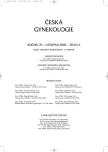Single Embryo Transfer Does not Compromise the Pregnancy Rate in Patients with Good IVF/ICSI Prognosis
Authors:
D. Koryntová; Martina Moosová; K. Řežábek; I. Pavelková; M. Mára
Authors‘ workplace:
MUDr. A. Martan, DrSc.
; Centrum asistované reprodukce, Gynekologicko-porodnická klinika VFN a 1. LF UK, Praha, přednosta prof.
Published in:
Ceska Gynekol 2005; 70(6): 435-439
Category:
Original Article
Overview
Objective:
Twin pregnancy is perceived as a suboptimal result of an IVF/ICSI cycle. The most effective way to reduce the number of twins in IVF/ICSI program is a single embryo transfer. The aim of our study was to compare the efficiency of elective single embryo transfer (eSET) and double embryo transfer (DET) in the couples with a very good prognosis of IVF/ICSI.
Design:
Prospective case observational study.
Settings:
Department of Obstetrics and Gynecology, Charles University, 1nd Medical Faculty and General Teaching Hospital, Prague, Czech republic.
Methods:
A prospective study focused on eSET was performed between 1. 1. 2003 and 31. 12. 2004. We offered eSET or eDET to 331 IVF/ICSI couples who met the following inclusion criteria: age of the women <35 years, 3 and more top quality embryos on day 4 after oocyte pick up. Fifty seven (17.2%) couples have chosen eSET and 274 (82.7%) couples preferred eDET. We compared clinical pregnancy rates in two groups of patients: In a group of patients who have chosen eSET versus patients who have preferred double embryo transfer (eDET). Student’s t-test and F test were used to compare both groups.
Results:
Patients in both groups were not significantly different in age, number of oocytes retrieved and total number of quality embryos. In the eSET group, we achieved 30 clinical pregnancies and the pregnancy rate (PR) was 52.6%. In the eDET group, 151 clinical pregnancies were observed and the PR was 55.1%. Although the pregnancy rate in the eDET group was higher than in the eSET group, the difference between the two groups was not statistically significant. We have not observed any twin pregnancy (0.0%) in the eSET group while 57 (37.7%) twin pregnancies and 1 pregnancy with 3 embryos (0.4%) have been observed in the eDETgroup. This difference is statistically significant (P<0.00001).
Conclusion:
In the group with a very good IVF/ICSI prognosis (women <35 years, 3 and more top quality embryos on day 4 after oocyte pick up), eSET did not significantly decrease the chance to achieve clinical pregnancy in comparison with DET. eSET seems to be a very efficient option to reduce the rate of twin pregnancy without compromising the pregnancy rate and should be recommended to these patients.
Key words:
single embryo transfer, pregnancy, twins, IVF/ICSI
Labels
Paediatric gynaecology Gynaecology and obstetrics Reproduction medicineArticle was published in
Czech Gynaecology

2005 Issue 6
Most read in this issue
- Rescue Cerclage in the Treatment of Cervical Insufficiency
- Obstetric Operation, Instrumental Delivery and 3rd Degree Perineal Tear and Anal Incontinence
- Plastic Adjustment in Hypertrophy of Labia Minora
- Single Embryo Transfer Does not Compromise the Pregnancy Rate in Patients with Good IVF/ICSI Prognosis
